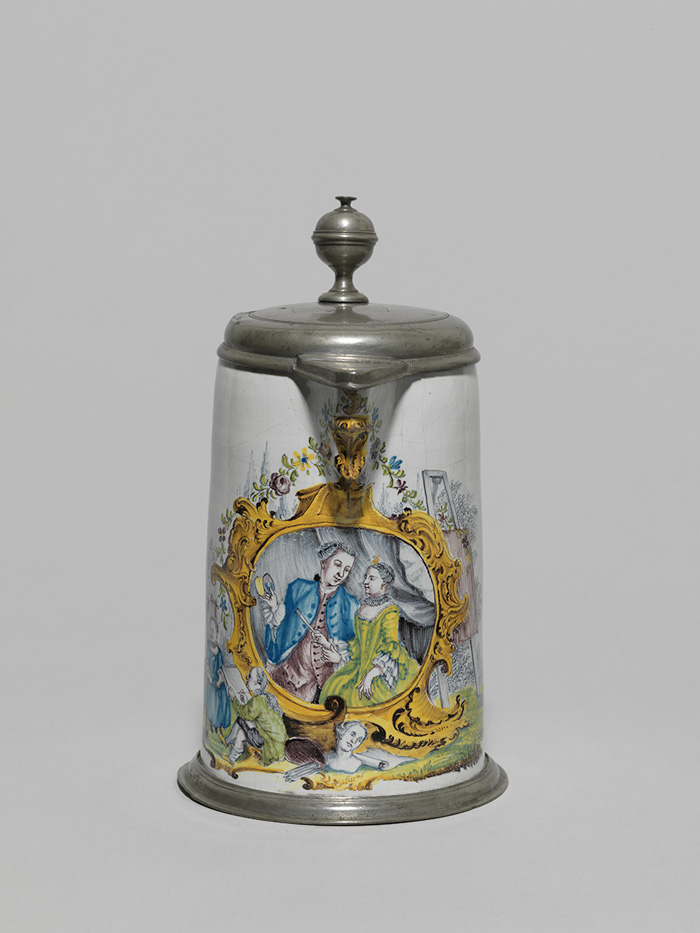Nuremberg Faience Ware in the Germanisches Nationalmuseum

Historical Premises
“Il a dû exister à Nuremberg un assez grand nombre d’usines, si l’on en juge d’après la variété des noms inscrits sous les pièces.“ With these words the great collector Albert Jacquemart (1808-1875) described in his Histoire de la Céramique of 1873 the type and size of the Nuremberg faience manufacture. Jacquemart still assumed, on the basis of the large number of surviving, signed works, that there must have been several factories in the former imperial city. The art of faience, which reached its height during the Baroque era, has come out of fashion today. When the first Chinese porcelain reached Europe, the glazed white and blue dishes attracted much interest (hence the English term china for porcelain). It was especially through the East India Company that large quantities of china came to Europe at the beginning of the 17th century. For decades Dutch sailors domineered the porcelain trade.
Delft
When the import from Asia slowed down in 1644, Delft ceramists began imitating the porcelain by establishing their own manufacture. They produced earthenware with a lead glaze that, according to today’s state of knowledge, contained 4% tin oxide. This small amount was enough to dull the glaze and to give the dishes a porcelain-like appearance after firing. Cobald oxide was used for the painted blue decorations. Remarkably, the faience ware thus manufactured was referred to in the sources as “Porcelain“ well into the 18th century. Factories copying Chinese ware, including its unusual motifs, were established quickly, spreading beyond Holland. Dutch potters trained in faience emigrated to other European countries where they tried to establish faience factories in imperial cities or principalities, promising the authorities and sovereigns good profits at the sale of their ware or, respectively, prestige and fame if the undertakings sponsored by them would produce outstanding results.
The Nuremberg Faience Manufacture
In May 1712, three pewterers and pewter merchants submitted a petition to the council of Nuremberg, asking for the construction of a porcelain factory (“Porcelainfabrique“). Heinrich Gottfried Anton Hammon, Johann Conrad Romedi and Christoph Marx were not only concerned with the production of faience but through their respective professions (goldsmith and pewterer), they hoped to gain additional income by applying faience tankards, pear-shaped tankards and narrow-necked jugs with silver or tin mountings. Accordingly, the production of such vessels in Nuremberg consisted of over half of the faience manufacture in the entire country.
Painted Decorations
Inspired by the factory founded in 1710 in the neighbouring Margraviate of Brandenburg-Ansbach and the painter Johann Kaspar Ripp, who later moved to the imperial city, the Nuremberg manufactory initially orientated itself in their decorations on Delft and Frankfurt models. During the first decade, the manufacture limited itself – apparently also because of cost – to painted blue decorations. Gradually the colour palette was extended and painters also started to work with heat-resistent underglaze pigments or in partial muffle colour. However, blue painted ware took precedence until the end of the factory’s heyday around 1780. The decorations too changed over the years. The paintings after Chinese models during the first years changed quickly in favour of graphic models, especially bible illustrations, engravings and genre paintings provided by local publishers and printers.
Painters
We know from signed objects that the paintersworking for the Nuremberg factory were outstanding, especially during the first two decades, until 1730. The factory was located in the Kartäusergasse, partly on the premises of the museum’s new building of 1993. The investigation into their work constitutes the basis of the present research project.
Current Research
Despite the large number of faience wares from the at one time 80 factories in Germany, faience is one of the still under-researched fields in the county. One reason is that a large part of surviving faiences have no marks or dates, making localisation and dating very difficult. The frequent moving of faience potters between factories within Germany complicates the clear separation and allocation of their works to the individual enterprises. Furthermore, there are few useful archival sources. By examining the sources in Nuremberg archives (state archive, municipal archive and regional church archive) as well as the systematic compilation of Nuremberg faience in European museums, it has been possible to establish an important foundation for the research of Nuremberg faience. The catalogue of the ca. 470 objects will introduce for the first time the large collection in the Germanisches Nationalmuseum.
Publication date: 2015
home Research Projects
Responsible
Dr. Silvia Glaser

Information and Services
Plan Your Visit
Opening Times
Location and Approach
GNM Museum Shop
FAQ
Library
Branches
Contact
